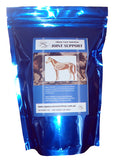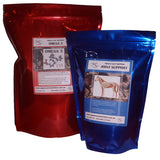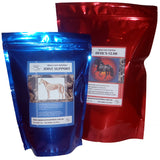DEVELOPMENTAL ORTHOPAEDIC DISEASE - PHYSITIS
By Sharon May-Davis
B.App.Sc.,Cert. Hon.(USA), M.App.Sc. ACHM, EBW, EMR

"Known species, through the process of natural selection, have evolved many unique and versatile structures in the struggle for existence." Charles Darwin 1859.
One could think that Darwin had Equus in mind when he wrote this statement. Its athletic prowess, versatility and adaptability to domestication inspired many an individual to breed for selected traits. However, many of those selected traits have now proven to be both taxing and arduous to its anatomical structure. Furthermore, in an attempt to meet specific demands, load-bearing structures have faltered and suffered accordingly.
Hence, we are now presented with an array of anatomical problems that require investigation. At present, Developmental Orthopaedic Disease or DOD is one such structural issue that requires specific attention. The American Quarter Horse Association first coined this umbrella term in 1986 and it encompasses all orthopaedic problems seen in the growing foal. These structural abnormalities can either individually or collectively render the athletic horse a statistical wastage within any industry. And furthermore, 67% of Thoroughbred foals exhibit DOD and 18.7% were not commercially viable. Thoroughbreds are not the only breed of horse that renders a high statistical percentage of DOD. Quarter horses, Standardbreds and Warmbloods experience this disease worldwide and at an alarming rate. This would explain why known contributory factors have come under considerable scrutiny over the last two decades. And particularly, the role that nutrition has played with its involvement in DOD.
Therefore, for the purpose of this exposé those known factors that influence the incidence of DOD and especially Physitis will be evaluated and reported. But perhaps more relevantly, those factors that can be influenced through managerial procedures to reduce the incidence of DOD will be dealt with extensively.
What is DOD ?
"Any disturbance of the skeletal growth in horses can be classified as Developmental Orthopaedic Disease." Avery 1996.
As the term Developmental Orthopaedic Disease implies, a range of skeletal problems associated with the growth and development in foals has been reported and documented. However, controversy exists over which diseases should be classified as DOD under this umbrella term. But to generalise, those diseases / disorders listed below are generally accepted as being part of the DOD complex:
- Osteochondrosis dissecans (OCD), Dyschondroplasia (DCP) or Osteochondrosis (OC) - are similar conditions that occur in the articulating cartilage or underlying bone.
- Physitis - changes in the growth plates. Also know as epiphysitis and physeal dysplasia.
- Angular limb deformities (ALD) - outward or inward deviation of the lower legs.
- Flexural deformities (FLD) - tightening or shortening of the flexor tendons in the lower leg.
- Subchondral cystic lesions (SCL) - fluid filled cysts occurring within the bone.
- Cervical vertebral malformation (CVM) - compression of the spinal cord in the neck.
- Cuboidal bone malformation - malformation of the small bones in the hock or knee.
In addition, it should be noted that each condition primarily involves a different region of the musculoskeletal system and accordingly, observations in the growth rate of young horses will exhibit different preliminary patterns. For example; a potential wobbler foal tends to eat with its legs wide apart and pace with its head held forward as early as 2 - 3 weeks of age. Physitis can be seen in foals as early as 1 month with noted enlargement of one or several growth plates in the distal (lower) limbs.
What causes DOD ?
" The outcome of various studies to causative factors have linked many variables to Developmental Orthopaedic Disease" Frape 1998.
What a dilemma ? Nevertheless, at least six notable areas have been isolated and are known causative factors of DOD. Fundamentally, those relating to:
- congenital malpositioning and or malnutrition.
- high rates of postnatal growth with unbalanced diets.
- biomechanical trauma.
- endocrinological dysfunction.
- toxicity, including iodine toxicosis.
- heredity.
Of these, physitis can be primarily attributed to high rates of postnatal growth with unbalanced diets. Biomechanical trauma, endocrinological dysfunction and hereditary factors are also recognised as causative agents. However, these ratings are altered significantly through managerial practices. For example: the incidence of DOD and physitis between studs alters with feeding practices and genetic influences. Physitis usually affects two distinct age groups: three to eight months, and one to two years. Visible evidence is often the first sign and lameness may or may not be apparent. Radiographic verification assists with a more accurate diagnosis and severity of the condition is quite variable. Fetlocks and knees are more commonly noticed, however, physitis will also affect hocks and lameness may ensue. Perhaps more importantly, physitis usually runs concurrently with FLD, it may also with OC and OCD, but often with ALD and Wobbler Syndrome. Therefore, in order to establish an early intervention program, a routine assessment should be conducted every 2 - 3 weeks of the growing foal. This will allow for the early detection of variations from the normal and facilitate the early implementation of planned managerial strategies.
What is Physitis ?
"Physitis is a problem that occurs at the growth plates of young horses that can make them sore and lame" Sellnow 1999.
The growth plate is a slightly more complex structure than illustrated in the simplified diagram to the right. Its layered composition stems from the epiphysis through to the metaphysis and consists of a cartilaginous portion known as the physis. This physis, as seen in the next diagram, consists of three zones that contain a layered sequence of significant cells. These germinal cells alter in structure to form bone. It is in this region of the long bone that physitis occurs. However, a second centre of ossification in the epiphysis can also be involved (epiphysitis), and is thought by some to lead to OC and OCD lesions. Physitis occurs when the process of turning cartilage cells into bone is disrupted. There are 2 distinct types:
1) overproduction of cartilage cells result in cellular death and
2) poor mineralisation of cartilage to bone development results in mico-fractures. This may result in either complete or incomplete structural breakdown, where the physis collapses. In either case the body responds by laying down more cells and the physis thickens accordingly.
Physitis - Management and Treatment
"Preventative measures are both pre and post natal" King and Mansmann1997.
Physitis is regarded as a non fatal, self resolving disease and as a result, has been overlooked as a primary research objective. Fundamentally due to the limited number of post mortems identifying it as the causative agent for death or necessitating euthanasia. Nevertheless, OC and OCD have been linked to another form of physitis, known as epiphysitis. These two diseases alone can render an elite equine athlete useless and cut short a valuable and productive career, including breeding stallions. The first signs of physitis can be usually noticed by a thickening of the growth plate regions. The areas of particular note are located at the end of long bones, especially those associated with the fetlocks, knees and hocks. Lameness is not commonplace, but has been attributed to physitis after x-rays have revealed irregularities associated with it. These can range from compression of the physis to fractures and a system of fracture configuration known as the Salter-Harris classification system has been developed. This system identifies those compromised regions.
Pre Natal
There are several areas where management can assist in preventing physitis.
- Select suitable parentage with no hereditary factors.
- Assess adlib water, soils and pastures to avoid toxicity, deficiency and excess during the pregnancy.
- Avoid obesity in mares as this can lead to malpositioning inutero.
- Maintain a balanced diet, especially Ca, P, Cu and Zn.
- Avoid undue stress in the third trimester.
Post Natal
As with pre natal conditions, there are a number of key areas where management can assist in the prevention of physitis.
- Regular monitoring of the foal's joints, condition score and growth rate.
- Monitor growth rates with a regular weighing program.
- Introduce a limited diet, exercise program or wean early (if possible) should rapid growth occur.
- Avoid confinement of more than 10 hours per day unless necessary.
- Avoid overfeeding energy or protein.
- Maintain a balanced diet, especially vitamins, minerals and trace elements ie.Vit.D, Ca, P, Cu, Zn, Mg, Mn and Mo.
- Avoid compensatory growth spurts ie. post weaning and or illness.
- Avoid large feeds as this promotes excessive insulin secretion, which can lead to early postprandial T4 clearance and growth hormone inhibition.
- Feed small meals frequently to avoid endocrinological inhibition.
- Avoid excessive biomechanical stress or fatigue on young bones and joints
- Maintain balanced feet.
- Educate employees to signs, symptoms and known causative factors.
Treatment
Once physitis has been identified, immediate treatment will shorten its onset and greatly reduce the incidence of permanent damage. Furthermore, treatment is dependent upon the severity of the condition and should be accurately assessed prior to a course of action. Lameness is not commonplace, but when evident, x-rays will determine the seriousness of the condition and an identifying format known as the Salter-Harris classification system has been developed for physeal injuries. This is based upon compression and or fracture configuration. However, it is important to remember that physitis is in most cases self limiting and resolving, but upon onset;
- Analyse the ration and alter accordingly, especially energy.
- Analyse size of ration and feed smallamounts frequently.
- Use the "buddy" weaning system and avoid stress.
- NSAIDS have been recommended by some researchers, such as Phenylbutazone and MSM (methyl sulfonyl methane).
- Stall rest may be necessary but only in balance with limited exercise.
- Cease vigorous exercise if a contributory factor.
- Assess hoof balance and alter accordingly.
In conclusion, "prevention is better than cure" certainly applies to Physitis.
|
RELATED PRODUCTS |
|||
 |
 |
 |
 |
| Joint Support | Joint Builder |
Joint Relief |
Devil's Claw |